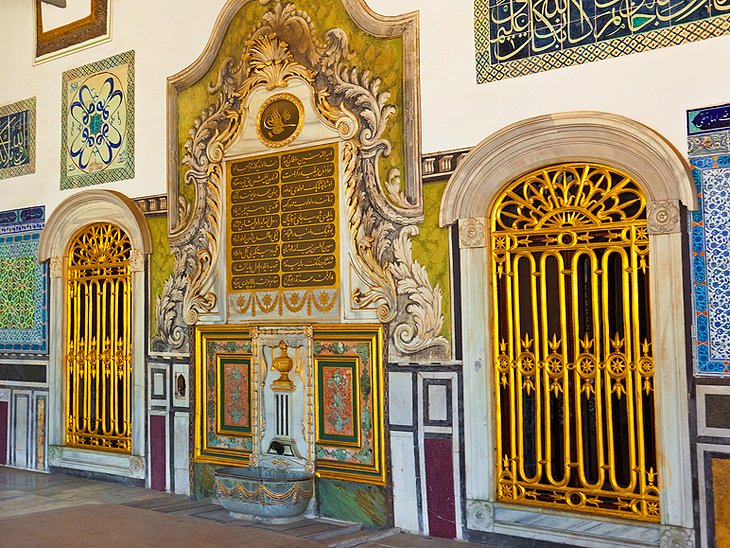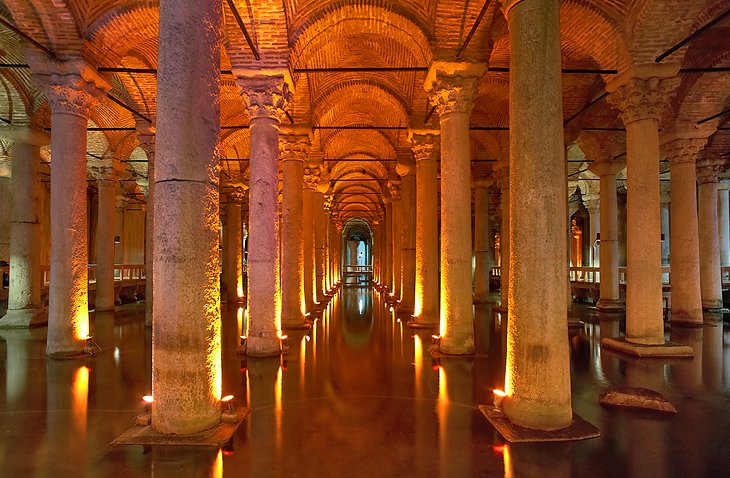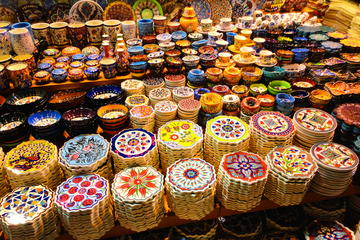Coveted by empires across the centuries, straddling both Europe and Asia, , Istanbul is one of the world's great metropolises. Founded around 1000 BC, the colony of Byzantium grew into the Byzantine Empire's great capital of Constantinople and after the Ottoman conquest of the city, retained its glorious place as the heart of their empire. The city (officially renamed Istanbul after the founding of the Turkish Republic) is liberally scattered with glorious remnants of its long and illustrious history, and the sightseeing here will impress even the most monument-weary visitor.
As well as the big four (Aya Sofya, Topkapi Palace, Blue Mosque, and Grand Bazaar), leave enough time to explore the other sights. Although many tourist attractions are located in, or near, the old city district of Sultanahmet, there is a dazzling array of other things to do throughout the farther reaches of the city. Plan your trip with our list of the top tourist attractions in Istanbul.
1. Aya Sofya

Aya Sofya
It's said that when the Byzantine Emperor Justinian entered his finished church for the first time in AD 536, he cried out "Glory to God that I have been judged worthy of such a work. Oh Solomon, I have outdone you!" The Aya Sofya (formerly the Hagia Sophia) was the emperor's swaggering statement to the world of the wealth and technical ability of his empire. Tradition maintained that the area surrounding the emperor's throne within the church was the official center of the world.
Through its conversion to a mosque, after the Ottoman armies conquered Constantinople, to its further conversion into a museum in the 20th century, the Aya Sofya has remained one of Istanbul's most cherished landmarks.
2. Topkapi Palace (Topkapi Sarayi)

Topkapi Palace (Topkapi Sarayi)
First built by Mehmet the Conqueror in the 15th century, this glorious palace beside the Bosphorus was where the sultans of the Ottoman Empire ruled over their dominions up until the 19th century. The vast complex is a dazzling display of Islamic art, with opulent courtyards lined with intricate hand-painted tile-work, linking a warren of sumptuously decorated rooms, all bounded by battlemented walls and towers.
Of the many highlights here, the most popular are the Harem (where the sultan's many concubines and children would spend their days); the Second Court, where you can walk through the vast Palace Kitchens and stand in awe at the dazzling interior of the Imperial Council Chamber; and the Third Court, which contained the sultan's private rooms.
The Third Court also displays an impressive collection of relics of the Prophet Muhammad in the Sacred Safekeeping Room and is home to the Imperial Treasury, where you're greeted with a cache of glittering gold objects and precious gems that will make your eyes water. To fully see Topkapi Palace, you'll need at least half a day.
Location: Babihümayun Caddesi, Gülhane Park
Official site: http://topkapisarayi.gov.tr/en
Istanbul - Canon Gate Palace Map
Istanbul - Harem in Topkapi Sarayi Map
3. Blue Mosque (Sultan Ahmet Camii)

Blue Mosque (Sultan Ahmet Camii)
Sultan Ahmet I's grand architectural gift to his capital was this beautiful mosque, commonly known as the Blue Mosque today. Built between 1609 and 1616, the mosque caused a furore throughout the Muslim world when it was finished, as it had six minarets (the same number as the Great Mosque of Mecca). A seventh minaret was eventually gifted to Mecca to stem the dissent.
The mosque gets its nickname from its interior decoration of tens of thousands of Iznik tiles. The entire spatial and color effect of the interior makes the mosque one of the finest achievements of Ottoman architecture. A great sightseeing joy of a trip to Istanbul is wandering amid the gardens sandwiched between the Blue Mosque and the Aya Sofya to experience their dueling domes in twin glory. Come at dusk for extra ambience, as the call to prayer echoes out from the Blue Mosque's minaret.
Directly behind the Blue Mosque is the Arasta Bazaar; a great place for a shopping stop as the handicraft shops here sell high-quality souvenirs. Even if you're not interested in a browse, head here to see the Great Palace Mosaic Museum, which is tucked between the Arasta Bazaar and the mosque. This small museum displays the 250-square-meter fragment of mosaic pavement that was unearthed in the 1950s here. Excellent information panels explain the mosaic floor's recovery and subsequent rescue.
Istanbul - Blue Mosque Map
4. Basilica Cistern (Yerebatan Sarniçi)

Basilica Cistern (Yerebatan Sarniçi)
The Basilica Cistern is one of Istanbul's most surprising tourist attractions. This huge, palace-like underground hall, supported by 336 columns in 12 rows, once stored the imperial water supply for the Byzantine emperors. The project was begun by Constantine the Great but finished by Emperor Justinian in the 6th century.
Many of the columns used in construction were recycled from earlier classical structures and feature decorative carvings. The most famous of these are the column bases known as the Medusa stones in the northwest corner with their Medusa head carvings. A visit here is very atmospheric with the columns beautifully lit and the soft, steady trickle of water all around you.
Location: Yerebatan Caddesi, Sultanahmet
Official site: https://www.yerebatan.com/en
5. Hippodrome

Hippodrome
The ancient Hippodrome was begun by Septimius Severus in AD 203 and completed by Constantine the Great in AD 330. This was the center of Byzantine public life and the scene of splendid games and chariot races but also factional conflicts. Today, there isn't much of the Hippodrome left to see, except for a small section of the gallery walls on the southern side, but the At Meydani (park), which now stands on the site is home to a variety of monuments.
On the northwest side is a fountain, presented to the Ottoman sultan by the German Emperor William II in 1898. Then, heading southwest are three ancient monuments: a 20-meter high Egyptian obelisk (from Heliopolis); the Serpent Column brought here from Delphi by Constantine; and a stone obelisk that originally was clad in gold-covered bronze plating until they were stolen by the soldiers of the 4th Crusade in 1204.
Popular Tours
6. Istanbul Archaeology Museum

Istanbul Archaeology Museum
Just a hop, skip, and jump away from Topkapi Palace, this important museum complex brings together a staggering array of artifacts from Turkey and throughout the Middle East, which sweeps through the vast breadth of history of this region. There are three separate sections in the complex, each of which are worthy of a visit: the Museum of the Ancient Orient; the main Archaeology Museum; and the Tiled Pavilion of Mehmet the Conqueror, which holds a staggering collection of ceramic art. As well as all the wonderful artifacts on display, don't miss the interesting Istanbul Through the Ages exhibit room in the main Archaeology Museum.









تعليقات: 0
إرسال تعليق